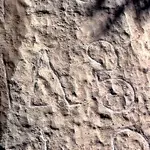the carvings in the photographs are modern...when one has examined true rock art, one notices, that the original art forms have formed a patina in the carving.
these photographs show distinctly, that the rock art is modern...no patina in the carving. looks as if it was done just for the photoshoot.
i believe this story was created to allow modern american expansion into the land of "savage and uncivilized" people.
chaco canyon, mesa verde, and several other impressive ruins caused much concern among the civilized people...since, these ruins, were better engineered than most modern buildings of the pioneer period in the americas.
Most petroglyphs in the southwest are carved on basalt, and many others on sandstone, volcanic tuff and other types of rock. A method of aging rock carvings has not been established. Some geologists have made age judgements based on microscopic analysis of exposed crystals on certain rock types, but even these methods have not been accepted by all. Weathering and mechanical erosion can be used to compare certain carvings against others on the same surface, but this too is sketchy because of the unknown quality of tools used. Some petroglyphs become overgrown with lichen - this allows one to determine how long the lichen has been in place, but this method too is sketchy and variable in accuracy.
Your 'patina' method method might occasionally be useful in a limited number of cases, but the carvings below were incised in limestone, which isn't susceptible to forming 'patinas'. The only judgement one can make about the carvings is that they were carefully created with sharp metal tools. Under a microscope, one might find evidence of the metal used and then try to date the technology used to make the tools, but this procedure would be a speculative long shot.
Perhaps the most acceptable method of dating rock carvings is cultural, which means attempting to determine what culture is responsible for creating them. This is tricky too, because of the 'copycat' option - carving a symbol from older cultures.
Bottom line: there is no way to date these petroglyphs without prior knowledge of who carved them and why. On this carving surface (very hard limestone), they could be very, very old. I believe they are less than 150 years old - maybe half that number - and were created in a very specific location relative to other petroglyphs and natural landmarks in the area. In other words, their location is of first importance, and their message, whatever it is, follows.
Kinkaid, if he existed, had nothing to do with these carvings, IMO.




